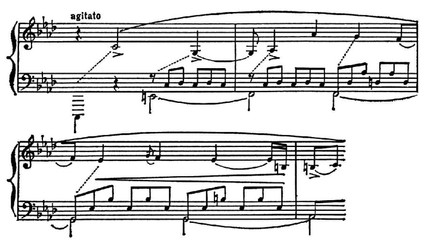
Syncope |
from the Greek synkope – truncation
Shifting the emphasis from a metrically stronger beat to a weaker one. A typical case is the extension of a sound from a weak time to a strong or relatively strong time:

etc. The term “C”, introduced in the ars nova era, is borrowed from grammar, where it means the loss of an unstressed syllable or vowel sound within a word. In music, it denotes not only the loss of an unstressed moment and the premature onset of an accent, but also any shifts in stress. S. can be both “anticipating” and “retarded” (see: Braudo I. A., Articulation, pp. 78-91), although this distinction cannot be made with complete certainty.
In strict-style polyphony, S., usually formed by delays, are essentially delayed:

In later polyphony, where dissonances are used freely, the preparations associated with the dissonant sound of the league take on the character of preceding C. In pl. cases, the direction of the shift cannot be established: such, for example, are the stresses between the metric. supports, creating a continuity of movement, as at the beginning of the allegro of the 1st part of Mozart’s symphony in D-dur (K.-V. 504). Main S.’s sign is a deviation of real accentuation from the normative one prescribed by the clock meter, which creates rhythmic. “Dissonances”, which are resolved at the moment of the coincidence of both accentuations:

L. Beethoven. 4th symphony, 1st movement.
To the rhythmic dissonances that require resolution belongs to the so-called. hemiola.
The deviation from normal accentuation gave rise to the theorists of the 17th century. attribute S. (syncopatio) to the musical rhetoric. figures, i.e., deviations from the usual mode of expression (as ancient rhetoric defined figures).
For the same reasons, the concept of S. was later extended to all types of non-metric. accents, incl. for cases when the emphasis on a weak beat is followed by a pause on a strong beat, not an extension of the sound (

), as well as temporary accents on a metrically weak beat, when it has a longer note duration than the previous strong one (see Lombard rhythm).
The last type includes many folklore rhythms; they are similar to antique. iambic or middle-century. 2nd mode, to-rye in the conditions of clock rhythm are perceived as S., but by their nature belong to an earlier rhythmic. a system where duration is not a means of accentuation and where the distribution of accents is not regulated by the measure (see Meter).
Thus, in these cases, there is no conflict characteristic of S. between the real and the metric. accentuation. The conflict between meter and accentuation in some cases activates the metric. supports (even if they are not implemented in the sound), creating an ext. jerks, emphasizing the exact tempo, in others – obscures the metric. supports and creates a kind of tempo rubato (“stealing tempo”).
S. of the 1st kind are characteristic of fast pace, especially in the classic. music (where “rhythmic energy” dominates), as well as for dance. and jazz music of the 20th century; S. of the preliminary type predominate here (for example, the beginning of the pianoforte of the sonata op. 31 No 1, G-dur and the coda from Beethoven’s Leonora No 3 overture, S. in many works by R. Schumann).
Rarely, the activation of meter and tempo is achieved by delayed S. (for example, Beethoven’s Coriolan overture, main part of P. I. Tchaikovsky’s Romeo and Juliet overture). In the romantic Music often encounters S. of the opposite, “rubat” nature. Rhythmich. in this case, dissonances sometimes remain without resolution (for example, at the end of Liszt’s piece “Bénédiction de Dieu dans la solitude” for piano):

P. Leaf. Benediction de Dieu dans la solitude, piece for piano.
In production romantics, delayed Cs are widely used. A typical technique is the delay of a melody, similar to suspension in the ornamentation of muses. baroque style (, performed) and representing a written out rubato, as it was understood in the 17-18 centuries:

F. Chopin. Fantasy f-moll for piano.
Anticipating S. among the romantics, and especially among A. N. Scriabin, sharpening the rhythmic. dissonances do not emphasize metric. pulsation.

P. Chopin. Nocturne c-moll for piano.
References: Braudo I. A., Articulation, L., 1965; Mazel L. A., Zukkerman V. A., Analysis of musical works. Elements of music and methods of analysis of small forms, M., 1967, p. 191-220.
M. G. Harlap



